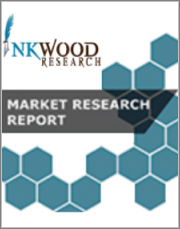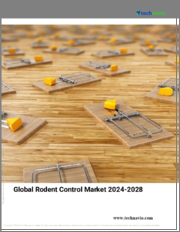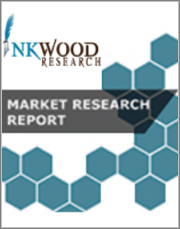
|
시장보고서
상품코드
1379516
세계의 쥐 방제 시장 예측(2023-2032년)Global Rodent Control Market Forecast 2023-2032 |
||||||
주요 조사 결과
세계의 쥐 방제(Rodent Control) 시장은 2023년부터 2032년까지의 예측 기간 동안 CAGR 6.52%로 추이하며 성장 할 것으로 예측됩니다. 쥐 방제는 쥐와 쥐와 같은 설치류의 개체수를 관리·감소시켜 피해나 건강 피해를 일으키지 않도록 하는 것입니다.
시장 인사이트
설치류는 주거지, 농장, 상업 시설, 농경지에 심각한 위협을 가하며 재산 피해, 식품 및 상수도 오염, 질병 전염 등의 문제를 일으킵니다. 이러한 문제를 해결하기 위해 쥐약이 널리 사용되고 있습니다. 설치류 방제를 위해 특별히 제작된 화학 제제인 쥐약은 미끼, 펠릿, 분말 등 다양한 제형으로 존재합니다. 쥐약은 설치류가 섭취하거나 흡입하면 중독을 유도하는 방식으로 작동합니다. 이러한 제품은 미끼 스테이션이나 기존 설치류 경로와 같이 설치류가 활동하는 지역에 전략적으로 배치됩니다. 쥐약은 설치류 개체수를 효과적으로 관리할 수 있지만, 비표적 종에 대한 잠재적 피해와 환경 위험으로 인해 사용에 주의가 필요합니다.
쥐 방제 솔루션 시장은 몇 가지 주요 요인에 힘입어 견조한 성장세를 보이고 있습니다. 설치류 침입과 관련된 건강 및 경제적 위험에 대한 인식 제고, 해충 매개 질병의 급증, 도시화 확대, 인구 증가가 주요 원인입니다. 효과적인 설치류 방제의 중요성에 대한 시장의 인식이 높아지면서 이러한 솔루션에 대한 수요도 증가하고 있습니다. 라임병과 뎅기열과 같은 해충 매개 질병의 발생률이 상승세를 보이고 있습니다. 설치류가 이러한 질병의 매개체 역할을 하는 경우가 많기 때문에 이러한 급증은 설치류 방제 서비스에 대한 수요 증가의 중요한 원동력입니다. 설치류는 렙토스피라증, 살모넬라증, 한타바이러스 폐증후군 등 다양한 질병을 사람에게 옮기거나 전파하여 공중 보건 및 경제에 상당한 위협이 됩니다. 설치류는 건강상의 위험 외에도 재산과 식료품에 피해를 입혀 기업과 주택 소유주에게 매년 상당한 재정적 손실을 초래할 수 있습니다.
지역별 통찰력
세계의 쥐 방제 시장의 성장 분석은 북미, 유럽, 아시아 태평양 및 기타 아시아 태평양로 분류하여 자세히 조사했습니다. 아시아 태평양은 예측 기간 동안 가장 높은 CAGR로 성장할 것으로 예상됩니다. 아시아 태평양에서는 해충 제거 회사가 디지털 해충 관리 시스템과 초음파 쥐 방제기에 현저한 중점을 두면서 최첨단 기술을 업무에 점차적으로 통합하고 있습니다.
이러한 첨단 기술은 전통적인 쥐 방제 방법의 효과와 효율성을 능가하고 환경의 지속가능성에 대한 관심 증가와 일치합니다. 아시아 태평양 정부는 쥐가 공중 보건에 초래하는 위협에 대한 인식을 강화하고 있습니다. 이 때문에 쥐 방제 프로그램에 대한 정부 지출이 증가하고 있습니다.
경쟁 인사이트
세계의 쥐 방제 시장 경쟁 구도은 예측 기간을 통해 격화되고 더욱 확대 될 것으로 예상됩니다. Bayer AG, BASF SE, Pelgar International 등 유명한 산업 플레이어들은 시장의 역학을 형성하는데 있어 매우 중요한 역할을 하고 있습니다.
목차
제1장 연구 범위와 조사 방법
제2장 주요 요약
- 시장 규모 및 추정
- 시장 개요
- 연구 범위
- 위기 시나리오 분석
- 주요 시장 조사 결과
제3장 시장 역학
- 주요 촉진 요인
- 설치류의 침입에 수반하는 건강 리스크와 경제 리스크에 대한 의식의 고조
- 유해 생물을 매개로하는 질병의 급증
- 도시화와 인구 증가
- 쥐 방제 솔루션에 주목하는 기업 증가
- 주요 억제 요인
- 살서제 화학물질에 의한 환경 문제
- 쥐 방제 제품이나 서비스의 고비용
- 쥐 방제 시장에 영향을 미치는 정부의 규제
제4장 주요 분석
- 상위 시장 분석 : 해충 방제 시장
- 주요 시장 동향
- Porter's Five Forces 분석
- 성장 전망 맵핑
- 시장 성숙도 분석
- 시장 집중도 분석
- 주요 구매 기준
- 유효성
- 사용의 용이성
- 안전성
- 수명
제5장 유형별 시장
- 화학
- 기계
- 바이오
- 기타 유형
제6장 용도별 시장
- 주택용
- 상업용
- 산업용
- 농업
- 기타 용도
제7장 지역 분석
- 북미
- 시장 규모 및 추정
- 북미의 쥐 방제 시장 성장 촉진 요인
- 북미의 쥐 방제 시장 과제
- 북미의 쥐 방제 시장 규제 프레임워크
- 북미의 쥐 방제 시장 주요 기업
- 국가별 분석
- 미국
- 미국의 쥐 방제 시장 규모 및 기회
- 캐나다
- 캐나다의 쥐 방제 시장 규모 및 기회
- 유럽
- 시장 규모 및 추정
- 유럽의 쥐 방제 시장 성장 촉진 요인
- 유럽의 쥐 방제 시장 과제
- 유럽의 쥐 방제 시장 규제 프레임워크
- 유럽의 쥐 방제 시장 주요 기업
- 국가별 분석
- 영국
- 영국의 쥐 방제 시장 규모 및 기회
- 독일
- 독일의 쥐 방제 시장 규모 및 기회
- 프랑스
- 프랑스의 쥐 방제 시장 규모 및 기회
- 이탈리아
- 이탈리아의 쥐 방제 시장 규모 및 기회
- 스페인
- 스페인의 쥐 방제 시장 규모 및 기회
- 벨기에
- 벨기에의 쥐 방제 시장 규모 및 기회
- 폴란드
- 폴란드의 쥐 방제 시장 규모 및 기회
- 기타 유럽
- 기타 유럽의 쥐 방제 시장 규모 및 기회
- 아시아 태평양
- 시장 규모 및 추정
- 아시아 태평양의 쥐 방제 시장 성장 촉진 요인
- 아시아 태평양의 쥐 방제 시장 과제
- 아시아 태평양의 쥐 방제 시장 규제 프레임워크
- 아시아 태평양의 쥐 방제 시장 주요 기업
- 국가별 분석
- 중국
- 중국의 쥐 방제 시장 규모 및 기회
- 일본
- 일본의 쥐 방제 시장 규모 및 기회
- 인도
- 인도의 쥐 방제 시장 규모 및 기회
- 한국
- 한국의 쥐 방제 시장 규모 및 기회
- 인도네시아
- 인도네시아의 쥐 방제 시장 규모 및 기회
- 태국
- 태국의 쥐 방제 시장 규모 및 기회
- 베트남
- 베트남의 쥐 방제 시장 규모 및 기회
- 호주 및 뉴질랜드
- 호주 및 뉴질랜드의 쥐 방제 시장 규모 및 기회
- 기타 아시아 태평양
- 기타 아시아 태평양의 쥐 방제 시장 규모 및 기회
- 세계 기타 지역
- 시장 규모 및 추정
- 세계 기타 지역의 쥐 방제 시장 성장 촉진 요인
- 세계 기타 지역의 쥐 방제 시장 과제
- 세계 기타 지역의 쥐 방제 시장 규제 프레임워크
- 세계 기타 지역의 쥐 방제 시장 주요 기업
- 지역 분석
- 남미
- 남미의 쥐 방제 시장 규모 및 기회
- 중동 및 아프리카
- 중동 및 아프리카의 쥐 방제 시장 규모 및 기회
제8장 경쟁 구도
- 주요 전략적 발전
- MERGERS & ACQUISITIONS
- PRODUCT LAUNCHES & DEVELOPMENTS
- PARTNERSHIP & AGREEMENTS
- BUSINESS EXPANSIONS & DIVESTITURES
- 기업 개요
- ABELL PEST CONTROL
- ANTICIMEX
- BASF SE
- BAYER AG
- ECOLAB INC
- MCCLOUD SERVICES
- NEOGEN CORPORATION
- ORKIN PEST CONTROL
- PELGAR INTERNATIONAL
- PLUNKETTS PEST CONTROL INC
- RENTOKIL INITIAL PLC
- ROLLINS INC
- SENESTECH CORPORATION
- SYNGENTA AG
- TERMINIX
KEY FINDINGS
The global rodent control market is expected to register a CAGR of 6.52% during the forecast period, 2023 to 2032. Rodent control is the process of managing and reducing populations of rodents, such as rats and mice, to prevent them from causing damage or posing health risks.
MARKET INSIGHTS
Rodents pose significant threats to residential properties, farms, commercial establishments, and agricultural areas, manifesting in issues like property damage, contamination of food and water supplies, and the transmission of diseases. To combat these challenges, rodenticides serve as a prevalent solution. Rodenticides, chemical formulations specifically crafted for rodent control, exist in various formulations such as baits, pellets, and powders. They function by inducing poisoning upon ingestion or inhalation by rodents. These products are strategically positioned in areas with rodent activity, such as bait stations or along established rodent pathways. While rodenticides effectively manage rodent populations, their use demands caution due to potential harm to non-target species and environmental risks.
The market for rodent control solutions is experiencing robust growth driven by several key factors. Heightened awareness regarding the health and economic risks associated with rodent infestations, a surge in pest-borne diseases, escalating urbanization, and population growth are pivotal contributors. As markets increasingly recognize the importance of effective rodent control, the demand for such solutions is on the rise. The incidence of pest-borne diseases, such as Lyme disease and dengue fever, is witnessing an upward trajectory. This surge is a significant driver for the growing demand for rodent control services, given that rodents often act as vectors for these diseases. Rodents present a substantial public health and economic threat by carrying and transmitting various diseases to humans, including but not limited to leptospirosis, salmonellosis, and hantavirus pulmonary syndrome. Beyond the health risks, rodents can inflict damage on property and food supplies, resulting in substantial financial losses for businesses and homeowners annually.
REGIONAL INSIGHTS
The global rodent control market growth analysis covers an in-depth study of North America, Europe, Asia-Pacific, and Rest of World. Asia-Pacific is expected to grow with the highest CAGR over the forecast period. In the Asia-Pacific region, rodent control companies are progressively integrating cutting-edge technologies into their operations, with a notable emphasis on digital pest management systems and ultrasonic rodent repellers.
These advanced technologies surpass the efficacy and efficiency of traditional rodent control methods, aligning with a heightened focus on environmental sustainability. Governments in the Asia-Pacific region are becoming increasingly aware of the threat posed by rodents to public health. This is leading to increased government spending on rodent control programs.
COMPETITIVE INSIGHTS
The competitive landscape in the global rodent control market is anticipated to intensify and is poised for further escalation throughout the forecast period. Prominent industry players such as Bayer AG, BASF SE, and Pelgar International etc., play pivotal roles in shaping the dynamics of the global market.
Our report offerings include:
- Explore key findings of the overall market
- Strategic breakdown of market dynamics (Drivers, Restraints, Opportunities, Challenges)
- Market forecasts for a minimum of 9 years, along with 3 years of historical data for all segments, sub-segments, and regions
- Market Segmentation caters to a thorough assessment of key segments with their market estimations
- Geographical Analysis: Assessments of the mentioned regions and country-level segments with their market share
- Key analytics: Porter's Five Forces Analysis, Vendor Landscape, Opportunity Matrix, Key Buying Criteria, etc.
- The competitive landscape is the theoretical explanation of the key companies based on factors, market share, etc.
- Company profiling: A detailed company overview, product/services offered, SCOT analysis, and recent strategic developments
TABLE OF CONTENTS
1. RESEARCH SCOPE & METHODOLOGY
- 1.1. STUDY OBJECTIVES
- 1.2. METHODOLOGY
- 1.3. ASSUMPTIONS & LIMITATIONS
2. EXECUTIVE SUMMARY
- 2.1. MARKET SIZE & ESTIMATES
- 2.2. MARKET OVERVIEW
- 2.3. SCOPE OF STUDY
- 2.4. CRISIS SCENARIO ANALYSIS
- 2.5. MAJOR MARKET FINDINGS
- 2.5.1. INCREASING SHIFT TOWARDS INTEGRATED PEST MANAGEMENT (IPM)
- 2.5.2. MANUFACTURERS NEED TO BE COMPLIANT WITH REGULATIONS
- 2.5.3. RESIDENTIAL AND COMMERCIAL END-USERS DOMINATED THE RODENT CONTROL MARKET
3. MARKET DYNAMICS
- 3.1. KEY DRIVERS
- 3.1.1. RISING AWARENESS ABOUT THE HEALTH AND ECONOMIC RISKS ASSOCIATED WITH RODENT INFESTATION
- 3.1.2. SURGE IN THE INCIDENCES OF PEST-BORNE DISEASES
- 3.1.3. INCREASING URBANIZATION AND POPULATION GROWTH
- 3.1.4. A GROWING NUMBER OF BUSINESSES ARE TURNING TO RODENT CONTROL SOLUTIONS
- 3.2. KEY RESTRAINTS
- 3.2.1. ENVIRONMENTAL CONCERNS ASSOCIATED WITH RODENTICIDE CHEMICALS
- 3.2.2. HIGH COST OF RODENT CONTROL PRODUCTS AND SERVICES
- 3.2.3. GOVERNMENT RESTRICTIONS AFFECTING THE RODENT CONTROL MARKET
4. KEY ANALYTICS
- 4.1. PARENT MARKET ANALYSIS: PEST CONTROL MARKET
- 4.2. KEY MARKET TRENDS
- 4.3. PORTER'S FIVE FORCES ANALYSIS
- 4.3.1. BUYERS POWER
- 4.3.2. SUPPLIERS POWER
- 4.3.3. SUBSTITUTION
- 4.3.4. NEW ENTRANTS
- 4.3.5. INDUSTRY RIVALRY
- 4.4. GROWTH PROSPECT MAPPING
- 4.5. MARKET MATURITY ANALYSIS
- 4.6. MARKET CONCENTRATION ANALYSIS
- 4.7. KEY BUYING CRITERIA
- 4.7.1. EFFECTIVENESS
- 4.7.2. EASE OF USE
- 4.7.3. SAFETY
- 4.7.4. LONGEVITY
5. MARKET BY TYPE
- 5.1. CHEMICAL
- 5.2. MECHANICAL
- 5.3. BIOLOGICAL
- 5.4. OTHER TYPES
6. MARKET BY APPLICATION
- 6.1. RESIDENTIAL
- 6.2. COMMERCIAL
- 6.3. INDUSTRIAL
- 6.4. AGRICULTURE
- 6.5. OTHER APPLICATIONS
7. GEOGRAPHICAL ANALYSIS
- 7.1. NORTH AMERICA
- 7.1.1. MARKET SIZE & ESTIMATES
- 7.1.2. NORTH AMERICA RODENT CONTROL MARKET DRIVERS
- 7.1.3. NORTH AMERICA RODENT CONTROL MARKET CHALLENGES
- 7.1.4. NORTH AMERICA RODENT CONTROL MARKET REGULATORY FRAMEWORK
- 7.1.5. KEY PLAYERS IN NORTH AMERICA RODENT CONTROL MARKET
- 7.1.6. COUNTRY ANALYSIS
- 7.1.6.1. UNITED STATES
- 7.1.6.1.1. UNITED STATES RODENT CONTROL MARKET SIZE & OPPORTUNITIES
- 7.1.6.2. CANADA
- 7.1.6.2.1. CANADA RODENT CONTROL MARKET SIZE & OPPORTUNITIES
- 7.2. EUROPE
- 7.2.1. MARKET SIZE AND & ESTIMATES
- 7.2.2. EUROPE RODENT CONTROL MARKET DRIVERS
- 7.2.3. EUROPE RODENT CONTROL MARKET CHALLENGES
- 7.2.4. EUROPE RODENT CONTROL MARKET REGULATORY FRAMEWORK
- 7.2.5. KEY PLAYERS IN EUROPE RODENT CONTROL MARKET
- 7.2.6. COUNTRY ANALYSIS
- 7.2.6.1. UNITED KINGDOM
- 7.2.6.1.1. UNITED KINGDOM RODENT CONTROL MARKET SIZE & OPPORTUNITIES
- 7.2.6.2. GERMANY
- 7.2.6.2.1. GERMANY RODENT CONTROL MARKET SIZE & OPPORTUNITIES
- 7.2.6.3. FRANCE
- 7.2.6.3.1. FRANCE RODENT CONTROL MARKET SIZE & OPPORTUNITIES
- 7.2.6.4. ITALY
- 7.2.6.4.1. ITALY RODENT CONTROL MARKET SIZE & OPPORTUNITIES
- 7.2.6.5. SPAIN
- 7.2.6.5.1. SPAIN RODENT CONTROL MARKET SIZE & OPPORTUNITIES
- 7.2.6.6. BELGIUM
- 7.2.6.6.1. BELGIUM RODENT CONTROL MARKET SIZE & OPPORTUNITIES
- 7.2.6.7. POLAND
- 7.2.6.7.1. POLAND RODENT CONTROL MARKET SIZE & OPPORTUNITIES
- 7.2.6.8. REST OF EUROPE
- 7.2.6.8.1. REST OF EUROPE RODENT CONTROL MARKET SIZE & OPPORTUNITIES
- 7.3. ASIA-PACIFIC
- 7.3.1. MARKET ESTIMATES & SIZES
- 7.3.2. ASIA-PACIFIC RODENT CONTROL MARKET DRIVERS
- 7.3.3. ASIA-PACIFIC RODENT CONTROL MARKET CHALLENGES
- 7.3.4. ASIA-PACIFIC RODENT CONTROL MARKET REGULATORY FRAMEWORK
- 7.3.5. KEY PLAYERS IN ASIA-PACIFIC RODENT CONTROL MARKET
- 7.3.6. COUNTRY ANALYSIS
- 7.3.6.1. CHINA
- 7.3.6.1.1. CHINA RODENT CONTROL MARKET SIZE & OPPORTUNITIES
- 7.3.6.2. JAPAN
- 7.3.6.2.1. JAPAN RODENT CONTROL MARKET SIZE & OPPORTUNITIES
- 7.3.6.3. INDIA
- 7.3.6.3.1. INDIA RODENT CONTROL MARKET SIZE & OPPORTUNITIES
- 7.3.6.4. SOUTH KOREA
- 7.3.6.4.1. SOUTH KOREA RODENT CONTROL MARKET SIZE & OPPORTUNITIES
- 7.3.6.5. INDONESIA
- 7.3.6.5.1. INDONESIA RODENT CONTROL MARKET SIZE & OPPORTUNITIES
- 7.3.6.6. THAILAND
- 7.3.6.6.1. THAILAND RODENT CONTROL MARKET SIZE & OPPORTUNITIES
- 7.3.6.7. VIETNAM
- 7.3.6.7.1. VIETNAM RODENT CONTROL MARKET SIZE & OPPORTUNITIES
- 7.3.6.8. AUSTRALIA & NEW ZEALAND
- 7.3.6.8.1. AUSTRALIA & NEW ZEALAND RODENT CONTROL MARKET SIZE & OPPORTUNITIES
- 7.3.6.9. REST OF ASIA-PACIFIC
- 7.3.6.9.1. REST OF ASIA-PACIFIC RODENT CONTROL MARKET SIZE & OPPORTUNITIES
- 7.4. REST OF WORLD
- 7.4.1. MARKET ESTIMATES & SIZES
- 7.4.2. REST OF WORLD RODENT CONTROL MARKET DRIVERS
- 7.4.3. REST OF WORLD RODENT CONTROL MARKET CHALLENGES
- 7.4.4. REST OF WORLD RODENT CONTROL MARKET REGULATORY FRAMEWORK
- 7.4.5. KEY PLAYERS IN REST OF WORLD RODENT CONTROL MARKET
- 7.4.6. REGIONAL ANALYSIS
- 7.4.6.1. LATIN AMERICA
- 7.4.6.1.1. LATIN AMERICA RODENT CONTROL MARKET SIZE & OPPORTUNITIES
- 7.4.6.2. MIDDLE EAST & AFRICA
- 7.4.6.2.1. MIDDLE EAST & AFRICA RODENT CONTROL MARKET SIZE & OPPORTUNITIES
8. COMPETITIVE LANDSCAPE
- 8.1. KEY STRATEGIC DEVELOPMENTS
- 8.1.1. MERGERS & ACQUISITIONS
- 8.1.2. PRODUCT LAUNCHES & DEVELOPMENTS
- 8.1.3. PARTNERSHIP & AGREEMENTS
- 8.1.4. BUSINESS EXPANSIONS & DIVESTITURES
- 8.2. COMPANY PROFILES
- 8.2.1. ABELL PEST CONTROL
- 8.2.1.1. COMPANY OVERVIEW
- 8.2.1.2. PRODUCTS / SERVICES LIST
- 8.2.1.3. STRENGTHS & CHALLENGES
- 8.2.2. ANTICIMEX
- 8.2.2.1. COMPANY OVERVIEW
- 8.2.2.2. PRODUCTS / SERVICES LIST
- 8.2.2.3. STRENGTHS & CHALLENGES
- 8.2.3. BASF SE
- 8.2.3.1. COMPANY OVERVIEW
- 8.2.3.2. PRODUCTS / SERVICES LIST
- 8.2.3.3. STRENGTHS & CHALLENGES
- 8.2.4. BAYER AG
- 8.2.4.1. COMPANY OVERVIEW
- 8.2.4.2. PRODUCTS / SERVICES LIST
- 8.2.4.3. STRENGTHS & CHALLENGES
- 8.2.5. ECOLAB INC
- 8.2.5.1. COMPANY OVERVIEW
- 8.2.5.2. PRODUCTS / SERVICES LIST
- 8.2.5.3. STRENGTHS & CHALLENGES
- 8.2.6. MCCLOUD SERVICES
- 8.2.6.1. COMPANY OVERVIEW
- 8.2.6.2. PRODUCTS / SERVICES LIST
- 8.2.6.3. STRENGTHS & CHALLENGES
- 8.2.7. NEOGEN CORPORATION
- 8.2.7.1. COMPANY OVERVIEW
- 8.2.7.2. PRODUCTS / SERVICES LIST
- 8.2.7.3. STRENGTHS & CHALLENGES
- 8.2.8. ORKIN PEST CONTROL
- 8.2.8.1. COMPANY OVERVIEW
- 8.2.8.2. PRODUCTS / SERVICES LIST
- 8.2.8.3. STRENGTHS & CHALLENGES
- 8.2.9. PELGAR INTERNATIONAL
- 8.2.9.1. COMPANY OVERVIEW
- 8.2.9.2. PRODUCTS / SERVICES LIST
- 8.2.9.3. STRENGTHS & CHALLENGES
- 8.2.10. PLUNKETTS PEST CONTROL INC
- 8.2.10.1. COMPANY OVERVIEW
- 8.2.10.2. PRODUCTS / SERVICES LIST
- 8.2.10.3. STRENGTHS & CHALLENGES
- 8.2.11. RENTOKIL INITIAL PLC
- 8.2.11.1. COMPANY OVERVIEW
- 8.2.11.2. PRODUCTS / SERVICES LIST
- 8.2.11.3. STRENGTHS & CHALLENGES
- 8.2.12. ROLLINS INC
- 8.2.12.1. COMPANY OVERVIEW
- 8.2.12.2. PRODUCTS / SERVICES LIST
- 8.2.12.3. STRENGTHS & CHALLENGES
- 8.2.13. SENESTECH CORPORATION
- 8.2.13.1. COMPANY OVERVIEW
- 8.2.13.2. PRODUCTS / SERVICES LIST
- 8.2.13.3. STRENGTHS & CHALLENGES
- 8.2.14. SYNGENTA AG
- 8.2.14.1. COMPANY OVERVIEW
- 8.2.14.2. PRODUCTS / SERVICES LIST
- 8.2.14.3. STRENGTHS & CHALLENGES
- 8.2.15. TERMINIX
- 8.2.15.1. COMPANY OVERVIEW
- 8.2.15.2. PRODUCTS / SERVICES LIST
- 8.2.15.3. STRENGTHS & CHALLENGES
- 8.2.1. ABELL PEST CONTROL












